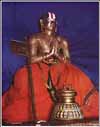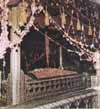|
|
 |
==Miniature
paintings emerge as an artistic genre (c.1000–1250):
Early
paintings are usually religious. "Workshops specializing in Buddhist
and
Jain texts are active in Gujarat, Bengal, and Nepal, while Rajasthani
centers
produce Hindu examples. They are noted for a linear, flat style and a
limited
palette" (--Met).
Examples from the 1000's: *Met*.
For comparison: religious art in Europe at the time, the *the
Aberdeen Bestiary*. |
 |
==Angkor
Wat (c.1113-50): The influence of the great Indian epics
spreads into Southeast Asia. Angkor Wat, in Cambodia, built by
Suryavarman
II, contains many motifs from India, including this depiction of the
Mahabharata
war. This huge and complex monument is dedicated to Vishnu. Then as
local
religious politics evolve, Jayavarman VII builds Angkor Thom and the
Bayon
temple (1181-c.1243), which are dedicated to all divinities under the
direction
of the Buddha (*flickr* |
 |
==Ramanuja
(c.1100-1200):
"Ramanuja, the poet and philosopher and patriarch of the Shrivaishnava
tradition, propounds the philosophy of vishishtadvaita, or qualified
monism,
and describes the theology of bhakti (devotion). He is credited with
travels
to the north of India and the introduction there of Shrivaishnavism" (--Met).
His commentary on the Vedanta Sutra: *George
Thibault*. |
 |
==Jayadeva's
"Gita Govinda" (c.1100-1200): At the court of King
Lakshmana Sena in Bengal, Jayadeva composes his Sanskrit poem about the
love of Krishna for the gopis, and supremely for Radha alone among
them.
"This erotic text is read and performed by Vaishnavas as an allegory
for
the longing of human souls for the divine, and lays the foundation for
representations of Radha and Krishna in painting from the sixteenth
century
onward" (--Met).
A multimedia presentation on the text: *IGNCA*. |
 |
==the
Jagannath Temple in Puri, Orissa, is built (1100's), with
its famous special forms of Krishna (Jagannath, "Lord of the World"),
Balbhadra,
and Subhadra-- and its famous chariot festival, from which we get the
English
word "juggernaut." The temple's official website: *jagannath*. [*Routes*] |
 |
==the
Lingayats (Virashaivas) appear: The Lingayats of
Karnataka
(c.1100 onwards) are radically independent and populist in their
theology;
for them, god is to be found only outside formal religious hierarchies.
Members of the group wear a Shiva-linga on their person at all times,
whence
their name. Discussion: *St.
Martin's College*. |
 |
==Muhammad
Ghuri's military successes: In 1186, Muhammad Ghuri of
Ghur
(*wikipedia*;
*1911
encyclopedia*), west of Ghazni, takes Lahore from the Ghaznavids,
thus
finishing off their dynasty; he commemorates his victory by building
the
"Minar-e Jam" (*wikipedia*;
*N.
H. Dupree*; *Dr.
V. Thewalt*), which soon help to inspire the Qutb Minar. Then in
two
battles at Tarain he first loses to (1191), then defeats (1192), the
Rajput
leader Prithviraj Chauhan. He moves on to defeat the Raja of Kannauj
and
take Banaras (1194). Discussion: *Ikram
Ch. 3*. |
 |
==Qutb
ud-Din Aibak occupies Delhi (1192-93): By Muhammad
Ghuri's
order, his military slave-general Qutb ud-Din Aibak occupies the
newly-conquered
Delhi and governs it as a part of the Ghurid kingdom. Qutb ud-Din
inherits
the fort recently renamed by Prithviraj Chauhan the "Qila Rai Pithaura"
(the former Lal Kot); he considers some building projects of his own. |
 |
==Hazrat
Mu'in ud-Din Chishti arrives (c.1190), spends time in
Lahore
and Multan, and finally settles down in Ajmer (Prithviraj's former
capital);
he dies there in 1236. Popular with the common people of all religions,
he is called "Gharib-Navaz" (Protector of the Poor), and his dargah in
Ajmer draws many visitors of all religions. The Chishtis are the most
widespread
Sufi order in South Asia, and the only order to have all their major
dargahs
(tombs of pirs) located in South Asia. Discussion: *Ali
Asani*; *Jim
Lochtefeld*. [*Routes*] |
 |
==Adhai
Din ka Jhompra, Ajmer, c.1199-1200: In Prithviraj's
former
capital, Qutb ud-Din Aibak, on behalf of Mu'izz ud-Din Muhammad Ghuri,
converts parts of an existing Jain temple into a mosque which he
calls
the "Hut of Two and a Half Days." [*Routes*] |











